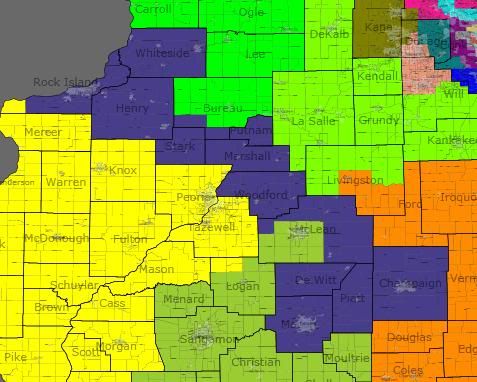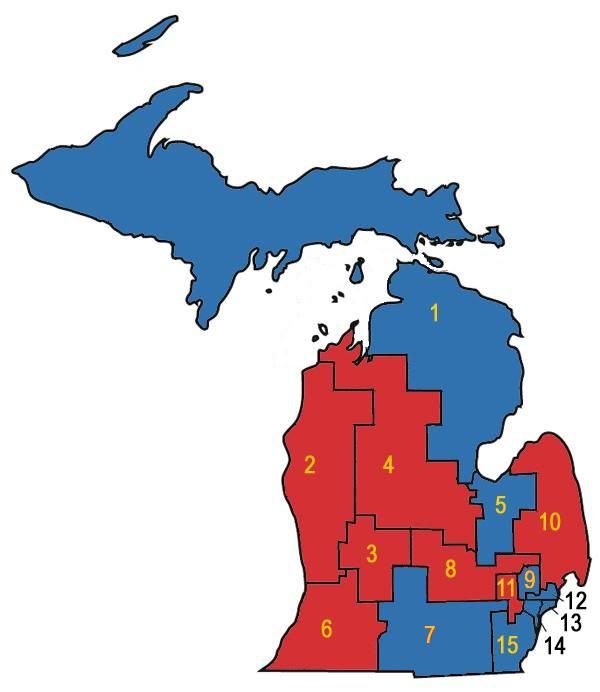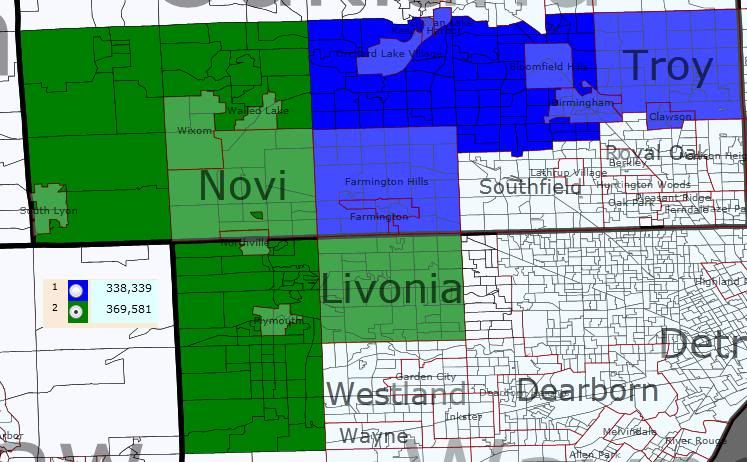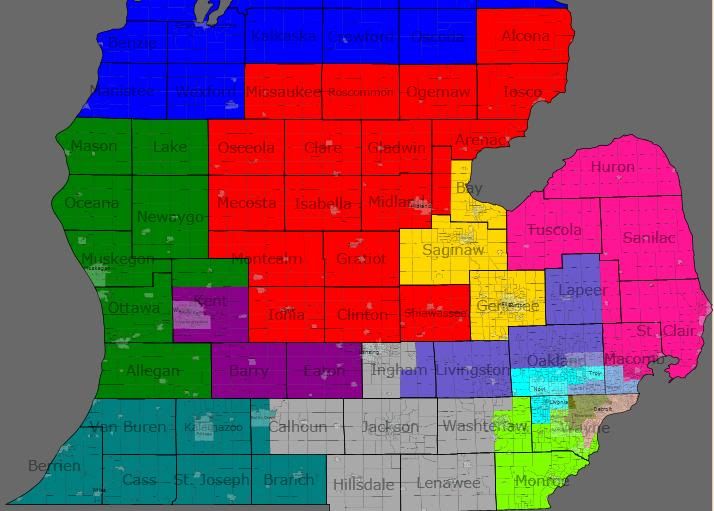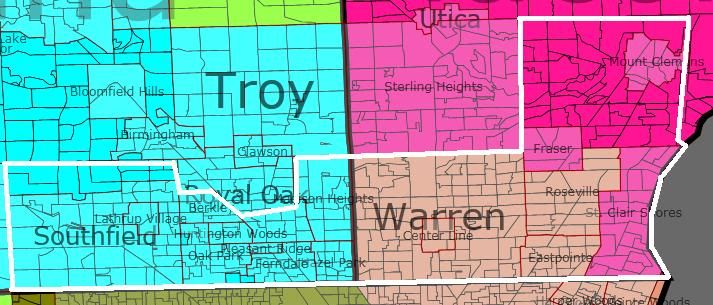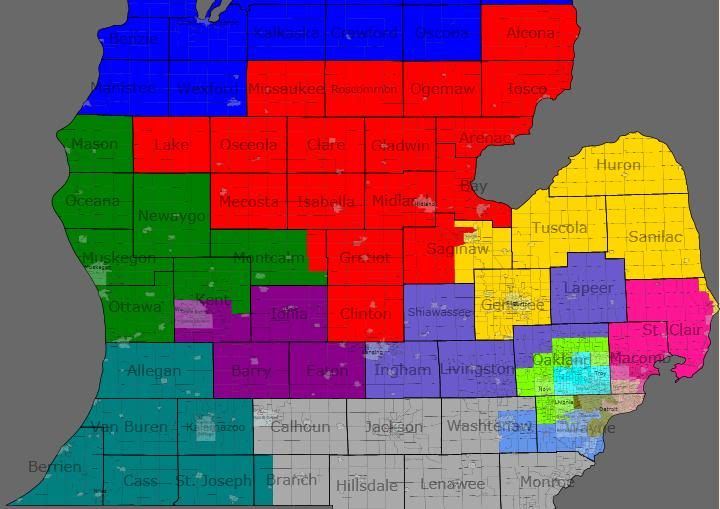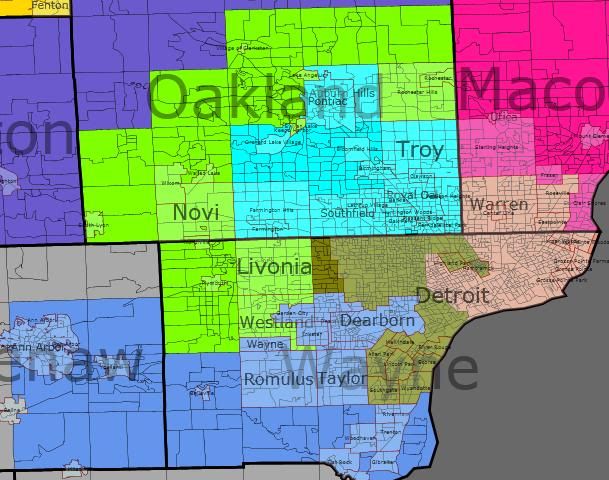This diary presents potential redistricting maps for Michigan, North Carolina, and Illinois. It also carries the ulterior motive of the following bleg:
I’ve started working on two related projects for Michigan for Dave’s App. I’m collating partisan data and renaming the voting districts by municipality name and precinct number. (Currently, Michigan’s voting districts are named using a 14 digit code.) I could use the following three forms of help:
1. I need a precinct map for the city of Detroit. This is looking ahead a bit, because Detroit is the final portion of the state I intend to work on, but it would really help. My Google-fu has failed me thus far.
2. In order to enable collaboration (see third form below), I need to figure out how to get the lines in my copy of vt26_d00.csv sorted by county and voting district number. The vt26_d00_data.csv file is already sorted like this, but its counterpart is somewhat helter-skelter. The solution that occured to me was to try sorting it using OpenOffice Calc (my only spreadsheet program), but that immediately lost leading zeroes, which breaks the CSV file. Any ideas out there?
3. Actual collaboration in collating and renaming. I’m currently going through the counties alphabetically. After two-ish weeks of sporadic effort, I just finished the H’s with Huron County. (On to Lansing’s Ingham County next!) That’s about 19% of the state population. Doing Flint’s Genessee County took most of the day yesterday, and I’m fairly frightened of Kent/Macomb/Oakland/Washtenaw/Wayne. Even if you’re just interested in helping with some of the smaller, easier counties, I’d be grateful. If you’re willing and interested, send me an email at my user name at gmail.com so that I can send you information about the conventions I’ve been using. Also, post a comment letting me know you emailed me — it’s a secondary email that I don’t otherwise check.
After the jump, you’ll see the following forms of actual content to assuage my conscience from this bleg:
Michigan: what my partisan map progress looks like so far and a potential Republican gerrymander (an abgin-esque atrocity by Michigan standards)
North Carolina: a Republican map that packs five Democratic incumbents into two districts
Illinois: an oxymoronic “good government” map of Illinois — I’m posting it mostly to show that two majority Hispanic districts in Chicago are easily created and to show off an particular idea for a reconfigured 17th district.
Michigan Partisan Progress So Far
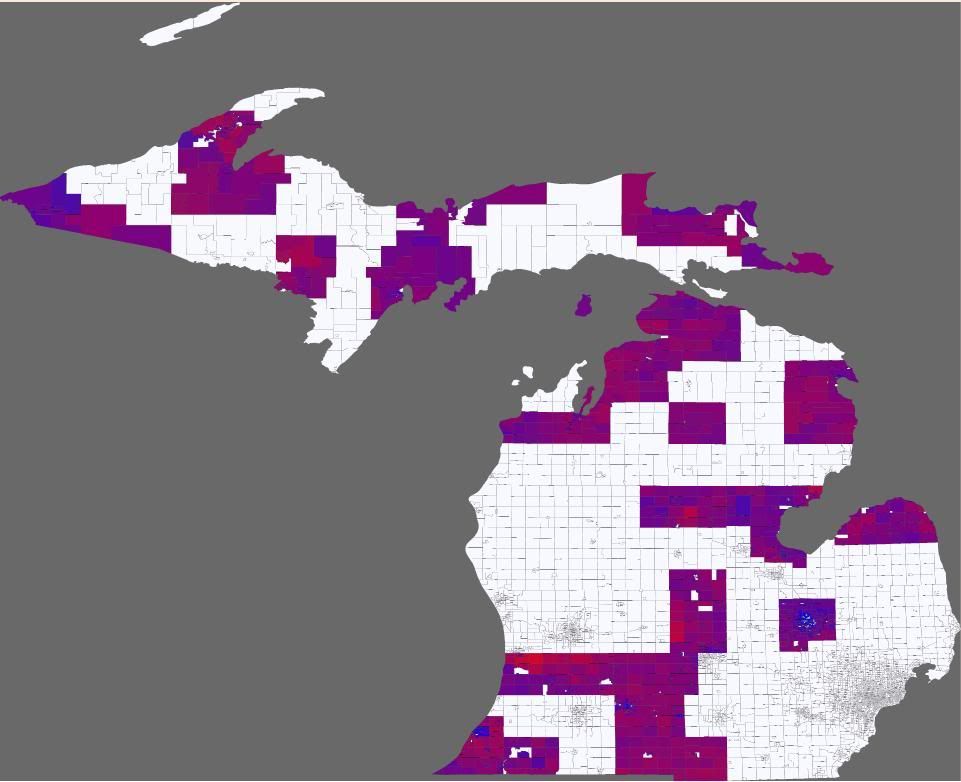
Michigan Republican Gerrymander
Michigan redistricting law heavily discourages county and municipality splitting. This map probably looks tame by most states’ standards, but it’s basically an abgin-esque “finding the limits” map by ours.
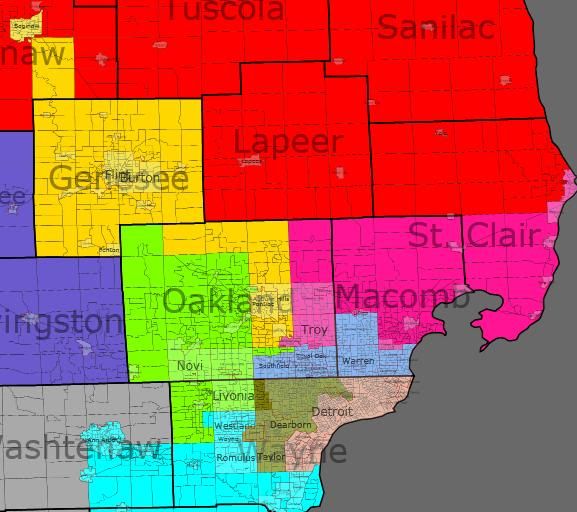
The Detroit-Ann Arbor-Flint CMSA
This map has its origins in a comment — I don’t recall which thread — that posited an I-75 district linking together Kildee and Peters. This is my attempt to make that district and show its consequences.
I started by painting in all of Genessee County (I really don’t think you can get away with having a district consisting of only portions of three different counties.) Then I painted in the bare minimum number of people to take in Saginaw City from Saginaw County — no GOP plan is going to saddle one of their representatives with Saginaw. Finally, I snaked down through Oakland County, taking heavily Democratic Pontiac and Peter’s home area of Bloomfield /Bloomfield Hills. That, as it turns out, is a district. So I started working other districts around it.
End result: Peter’s 9th district has been eliminated by trisection. Its eastern third is now in Miller’s 10th, its central third is in Kildee’s 5th, its western third is in McCotter’s 11th.
I won’t dissect the districts in detail, but suffice it to say that I think this is a fairly successful Detroit-area map for the GOP. McCotter gets majorly shored-up (although he might at primary risk from an Oakland-based politican), Miller probably washes out in trading the Thumb for eastern Oakland, and Peters gets the short end of the reapportionment stick.
Taking a look statewide…
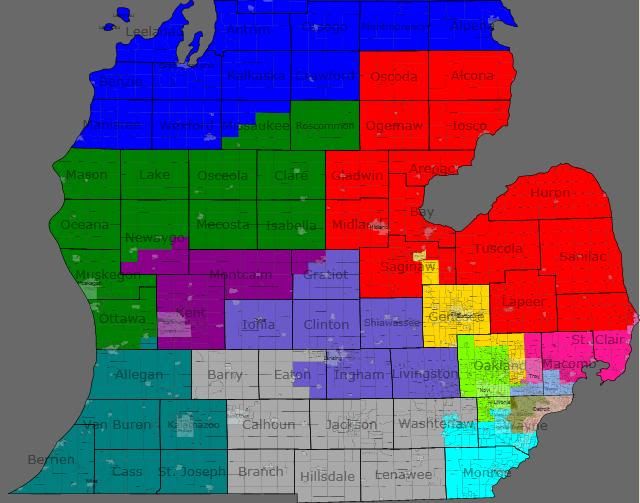
… there are some interesting repercussions, mostly favorable to the Republicans. Starting with one of the pieces of bad news, however, with the 5th and 10th sucked down into the Detroit area, the 4th is forced to cover the Thumb. Dave Camp becomes an incumbent in-name only, with only his home county of Midland and the western portion of Saginaw County overlapping between his current district and this one. I would guess that this district is at least as Republican as his current one, but I’m not entirely sure.
With the 4th swinging east, the 1st gets to pick up the Republican-leaning Traverse City area, mildly shoring up Benishek. The 2nd and 3rd also get pulled north by the 4th’s relocation. That, in turn, allows Upton to take in all of Republican Allegan County and Walberg to newly acquire heavily Republican Barry County — a significant upgrade for him that I’ve been otherwise unable to find. I’m genuinely unsure about how the changes to Roger’s 8th district pan out — he loses Republican northern Oakland, and gains some swingy territory in central Michigan along with fairly Republican (I think) Ionia County.
Summary: This map definitly eliminates a Democratic incumbent. I think it also shores up four Republican incumbents while severely inconveniencing another, with the effects on yet another being unknown.
North Carolina Republican Gerrymander

This map has its origins in SaoMagnifico’s recent Wyoming Rule diary on North Carolina. While composing a counter-suggestion to his proposed map, I discovered that there’s a significant African American population in and around Fayetteville. I’ve seen some insisting that this population could be linked with Raleigh’s to produce a new VRA-seat. My attempts at drawing that district while preserving the current 1st have failed, but it turned out to work well when linked with Charlotte’s African-American population instead.
This is a 7-4-2 Republican/Democratic/swing map.
A quick run-through:
The 1st district (blue) stays more or less in place. VRA: 49% black, 44% white (is this kosher?). 2008: Obama 62%, McCain 37%.
The 2nd district (green) shifts substantially west. Still contains all of Ellmer’s (and Etheridge’s) Harnett County. 2008: McCain 56%, Obama 43%.
The 3rd district (purple) now hugs the coast all the way down to (and including) Wilmington. Incumbent Jones is (barely) drawn outside the lines, but I’ve been told he’s outside the lines already. 2008: McCain 57%, Obama 42%.
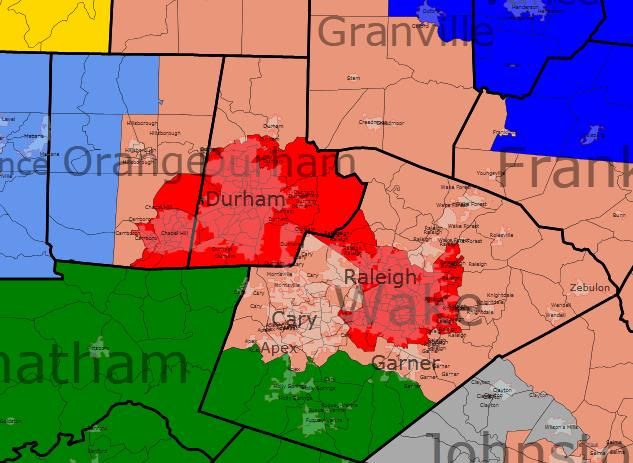
The 4th district (red) packs Price and Miller into one uber-Democratic (majority-white) district. 2008: Obama 73%, McCain 26%.
The 5th district (yellow) continues to hug the northwest corner of the state. Foxx now lives in her district. 2008: McCain 60%, Obama 38%.
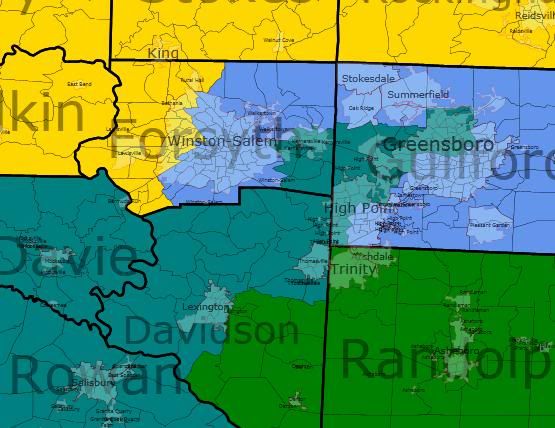
The 6th district (teal) shifts west. This is kind of like a bizzaro-12th, covering broadly similar territory between Charlotte and Greensboro, but with the intention of being a Republican district instead of an African-American gerrymander. Coble still lives here, I think. If not, he’s close. 2008: McCain 56%, Obama 43%.
The 7th district (grey) is still in the southeast corner of the state, reaching north into the eastern parts of the old 2nd — but it’s been reconfigured to exclude incumbent McIntyre. 2008: McCain 56%, Obama 43%.
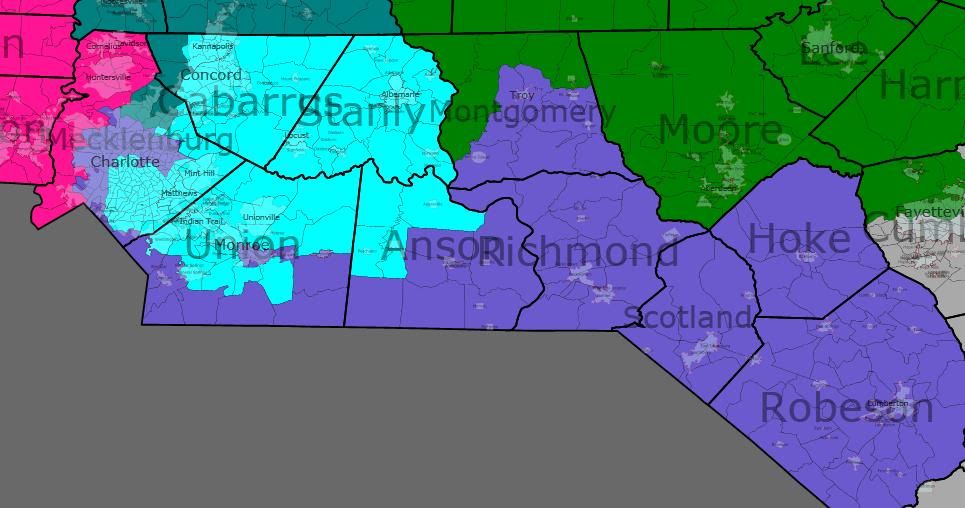
The 8th district (slate blue) is the center-piece of this plan. It strings together all three of Watt, Kissell, and McIntyre into a minority-majority district. VRA: 41% black, 35% white, 13% Hispanic. 2008: Obama 66%, McCain 33%.
The 9th district (cyan) now lies exclusively east of Charlotte. So far as I know, Myrick still lives in the district. 2008: McCain 55%, Obama 44%.
The 10th district (magenta) pulls in closer to Charlotte. 2008: McCain 59%, Obama 40%.
The 11th district (lime) stays in place. 2008: McCain 52%, Obama 46%.
The 12th district (cornflower) is a (majority white) Democratic new open seat in the Triad. Effectively, the Republicans get rid of both of McIntyre and Kissell and replace them with a Triad-area Democrat. 2008: Obama 60%, McCain 38%.
The 13th district (salmon) is a swing(!) district surrounding the Triangle. 2008: McCain 50%, Obama 49%.
If not screwing with Shuler is something you can’t see the Republicans doing, here’s an area map for the changes necessary:
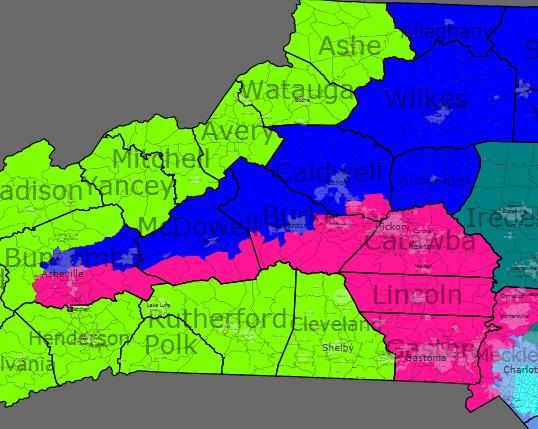
(Please ignore the 5th changing colors.]
New stats
5th: 56 Mc / 42 Ob
10th: 57 Mc / 42 Ob
11th: 58 Mc / 42 Ob
Illinois Good-Government Redistricting

This map was drawn to avoid splitting counties and muncipalities — an idea I support in the abstract if not necessarily in practice. I won’t go into detail at all about it, because I don’t feel like I understand Illinois well enough. But I wanted to draw attention to two features to see what people think who do understand Illinois politics. (The 11th and 16th — both green — can be hard to distinguish. DeKalb, LaSalle, and points east are in the 11th.)

Feature one: Here’s the VRA statistics for most of the Cook County districts.
1st (blue) — white 39%, black 53%
2nd (green) — white 26%, black 58%, Hispanic 10%
3rd (purple) — white 75%, Hispanic 16%
4th (red) — white 25%, black 12%, Hispanic 59%
5th (yellow) — white 32%, Hispanic 51%
7th (grey) — white 29%, black 53%, Hispanic 16%
9th (cyan) — white 66%, Asian 13%, Hispanic 12%
Actual census numbers may change this, of course, but 2 VRA Hispanic district seem possible with a miminum of fuss.
Feature two: Note district 17 [dark blue] in the whole-state map above. It links together the Quad Cities, Bloomington-Normal, and Champaign-Urbana. Is this a workable Democratic district?
If not — I’ve gotten the impression that Bloomington-Normal is fairly Republican for a mid-sized city — how about this, which substitutes in Decatur?
